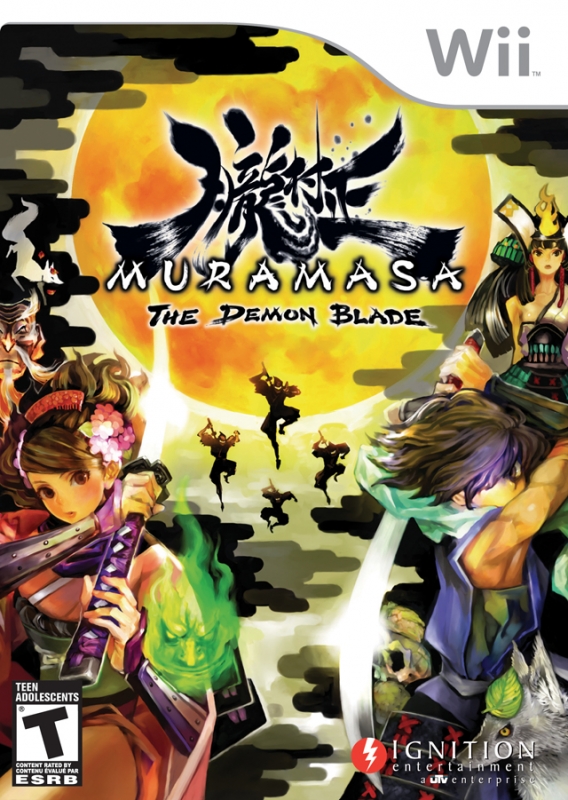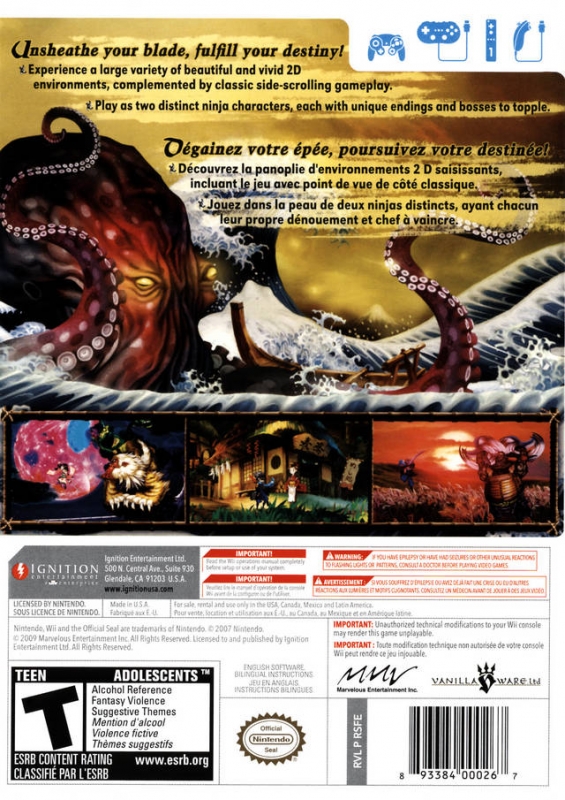Existing User Log In
New User Registration
Register for a free account to gain full access to the VGChartz Network and join our thriving community.





America - Front


America - Back

08th Sep 2009 | 1,709 views
Following in the traditions of its predecessors such as Odin Sphere and Princess Crown, Muramasa: The Demon Blade continues with much of the same formula. Beautiful hand drawn backgrounds and characters. An interweaving storyline connected to the playable characters. And a heavy influence to folklore. But it is easy to see after just a few minutes of playing, this game has made quite an upgrade from the previous Vanillaware titles it takes after.
Game Settings and Story:
Beginning the game is a choice to play as one of the two characters. Either Momohime, the possessed daughter of a feudal lord who disappears with a stolen sword or Kisuke, a fugitive Ninja with amnesia who is being hunted by his clan for a crime he can't remember committing. This helps divide the games story into more manageable parts, as the main story segments show up before and after bosses as short Anime-style cutscenes. This cuts down on some of the long cutscenes that would be found in some of the past Vanillaware games such as Odin Sphere, some which could go on as long as 10 minutes, and gets the player back into the action without sacrificing story.
The game takes place over the course of acts, divided up by Anime style cutscenes before and after boss fights. Momohime starts on one side of the games map while Kisuke starts on the other. And with around 15 different provinces to explore, each with its own bosses and secret areas to unlock, the game doesn't slouch on size.
You can also pick one of two difficulty settings initially, with a third after completing the games story mode. While the amount of enemies or bosses don't change in either mode, the tactics they employ and the damage they deal do. But don't worry, if you pick the harder of the two modes, known as 'Shura', the game will let you know. This game is not your average 2D platformer, it has some major fight to it and you will die from time to time. And you will get a good 20-30 hours hours out of the main game in this mode.
Maybe most importantly to some is the controls. Being a 2D Action/RPG that is highly focused on speed and timing, the game doesn't feature controls that are unique to the Wii, such as the Wiimote motion controls. However, three different controllers are supported for playing the game: The Wiimote and Nunchuck, The Classic Controller and The GameCube controller.
The Gameplay:
As for the gameplay itself, once again, Vanillaware took inspiration from their past titles. But if you are a fan of their past games, this title will almost seem like playing a whole new game. Combat is so fast paced, early on it will seem like you don't know what you are doing. However, soon you realize the combat engine is a simple yet well designed system of stunning enemies in the air and chaining combos with visual timing. And initially boss battles seem overwhelming, but with the right items and mastery of combat, they are brought down to size.
Controlling this timing based melee system boils down to three major actions, each focused on by a single button. The majority of attacks with the sword utilize the A button on all three controller options, performing normal sword slashes that lead into combos. When you then hold the A button and move the D-Pad or Joystick in varying ways, you perform new moves beyond the basic sword slashes such as a windmill style jump or an upward slash. Holding down the attack button also serves another purpose, as you are able to block oncoming physical attacks and parry projectiles. Mastering combat with the sword comes down to alternating between attacking and blocking oncoming attacks, both using the same button.
Two more actions are crucial to gameplay however, and those are Quick Draw and Secret Arts. Quick Draw is a mechanic that attacks all opponents on the screen when you draw a new blade. While not indefinite, it only appears after a certain amount of time has gone by in battle and the sword is glowing, it helps you in both boss battles and regular battles. The second mechanic is Secret Arts which is simply the latent abilities your sword has. Every sword in the game has its own latent abilities which use up some of its Soul Power. But these powers can be a great aid to you just like the Quick Draw, from stunning great amounts of enemies to killing one enemy instantly. The variety of each swords power is immense, and you have three equipped at all times.
The ability to equip three blades simultaneously might seem overkill at first, but since enemies are able to break your weapons, you are going to want to have backup. And with up to 30 enemies attacking you at once, your sword breaks often and you are forced to switch to the next very quickly. Much of the game is based on this mechanic of switching swords, which is a benefit to you since you are going to want to be doing this often.
Items:
Along with the vastly improved combat engine is the new use for items. Once again restoration items and cooking have returned like in Odin Sphere. But this time, you are able to obtain recipes and books which give your character the ability to cook food while on the go. Simply by obtaining items while traveling or from a merchant, your character can now cook up their own healing items instead of having to return to a NPC to buy them. This is very helpful when you are about to fight a boss and need those few extra Rice Ball or Roasted Squid and don't want to go all the way back to a merchant. As well there are a number of accessories to find which you can equip to your character for a number of effects from raising your strength to resisting status effects. When you add to this the 108 different blades to find or forge, much of the games RPG characteristics become clear.
The Good and the Bad:
One thing that may be a possible deal breaker for some is the 'RPG' elements in this otherwise Action/Platformer. Though much of the RPG influences might seem forced at first, such as having to cook food or talk to NPCs directly to obtain key story points and items, much of the rest of the games RPG elements are very subtle. Like in Symphony of the Night, the game plays much like a 2D Action/Platformer, with the RPG elements such as level acquisition and items all regulating themselves to the background menu screen. They do directly influence your character such as the level of blade you can use, but they don't directly affect the combat.
Another thing some people might have a hard time with is the vastness of the game. The game is a free roaming game, meaning that after you complete and area, like in a Metroid or Castlevania title, you must travel back through it to get to a different area if you are directed to go that way. The downfall to this is going through the same areas over again. The benefit to this is added experience from more battling, exploring more parts of a province you didn't before and the fact that the game allows you to go anywhere you want to. Though word to the wise, there are barriers in each province blocking your way until you obtain certain swords, keeping the game from being truly 'free roaming' until the end of the game. One good point is that after completing the game, you are able to warp to different provinces via the save stations.
The third major point of interest that will be a controversial subject for some is the localization and style of the game. Heavily rooted in both Japanese Folklore and Anime design, little was changed when the game was brought over to America, including the Japanese text and the Japanese voices being left intact throughout. This left a very distinct and heavy unique flavor for the game which the majority of America usually sees dubbed and many might not be accustomed to. But have no fear, all of the games Japanese dialogue and text has corresponding English text.
Presentation and Graphics:
Another area the game definitely excels at is presentation. From the moment you turn the game on to every use of a menu, interaction of two character or even the combat engine itself, you can tell they wanted the games interface to be so slick it was second nature. Navigating menus is instantaneous, equipping can be done instantly and they give you the option to skip story sequences (if you want it). The entire game itself is one of the more polished games of recent times. The best way to describe it is, it has virtually no load times, hardly any noticeable slowdown and such intuative menu systems that you just don’t even think about it. And that’s how you know the game did it right.
Also, like in Odin Sphere, Hitoshio Sakimoto and his team have once again returned to do the music for this game. Much of the music fits the games atmosphere just as you would expect from a game set in the mid-1800s Japan. Other pieces feel very modern, with an upbeat Electronica vibe that sounds very Asian in its own right. The music fits the game very well, but can get a little annoying if you stay in one Province too long.
Finally, the last important point to bring up is the graphics. And this is most definitely the games strongest point, in a game full of powerful positives. Lush backgrounds literally pop out of every screen and don't be surprised if you stop just to look at some of the amazing art of some of the locations in this game. From battling on giant ancient tree limbs to running across the tile of a giant Edo castle to getting lost in a bamboo forest, nearly every kind of mid-1800s Japanese setting is represented, in breathtaking flair and detail. But even more amazing than the backgrounds may be the detail put into the characters themselves. Whether they are enemies you see over and over or just a boss you only see once, or even the simple shopkeeper trying to feed you Mizuyokan, every character seems to have the same amount of stunning detail. And Vanillaware is not shy about showing this off, with a number of subtle and not so subtle events that show off their characters in ways that will make you notice them to say the least.
-----
In closing, as this game is part of a small sub genre if gaming that is still trying to perfect itself, its hard to define its exact improvement to the 2D Action/RPG genre. The game is without question a significant improvement for Vanillaware titles and it is safe to say that fans of games along the vein of Symphony of the Night or anyone who is just looking for the next great product from Vanillaware will love this game. But to ask if this game will make a splash in the 2D Action/RPG genre, the answer probably depends on if it sells.
|
|
|
|
|
|
|
|
|
|
|
|
|
|
|
|
|
thetonestarr
posted 06/09/2011, 01:01
I love this game. It's a LOT of fun, and it's breathtakingly gorgeous too. Message | Report |